Toxicity of Chlordane: Occupational and Environmental Implications
VerifiedAdded on 2023/03/17
|13
|1234
|89
Presentation
AI Summary
This presentation provides an overview of the toxicity of chlordane, including its routes of exposure and associated health effects. It discusses the occupational exposures and pre-hospital management of chronic chlordane exposure. The presentation also highlights the importance of thorough training to enhance safety measures.
Contribute Materials
Your contribution can guide someone’s learning journey. Share your
documents today.
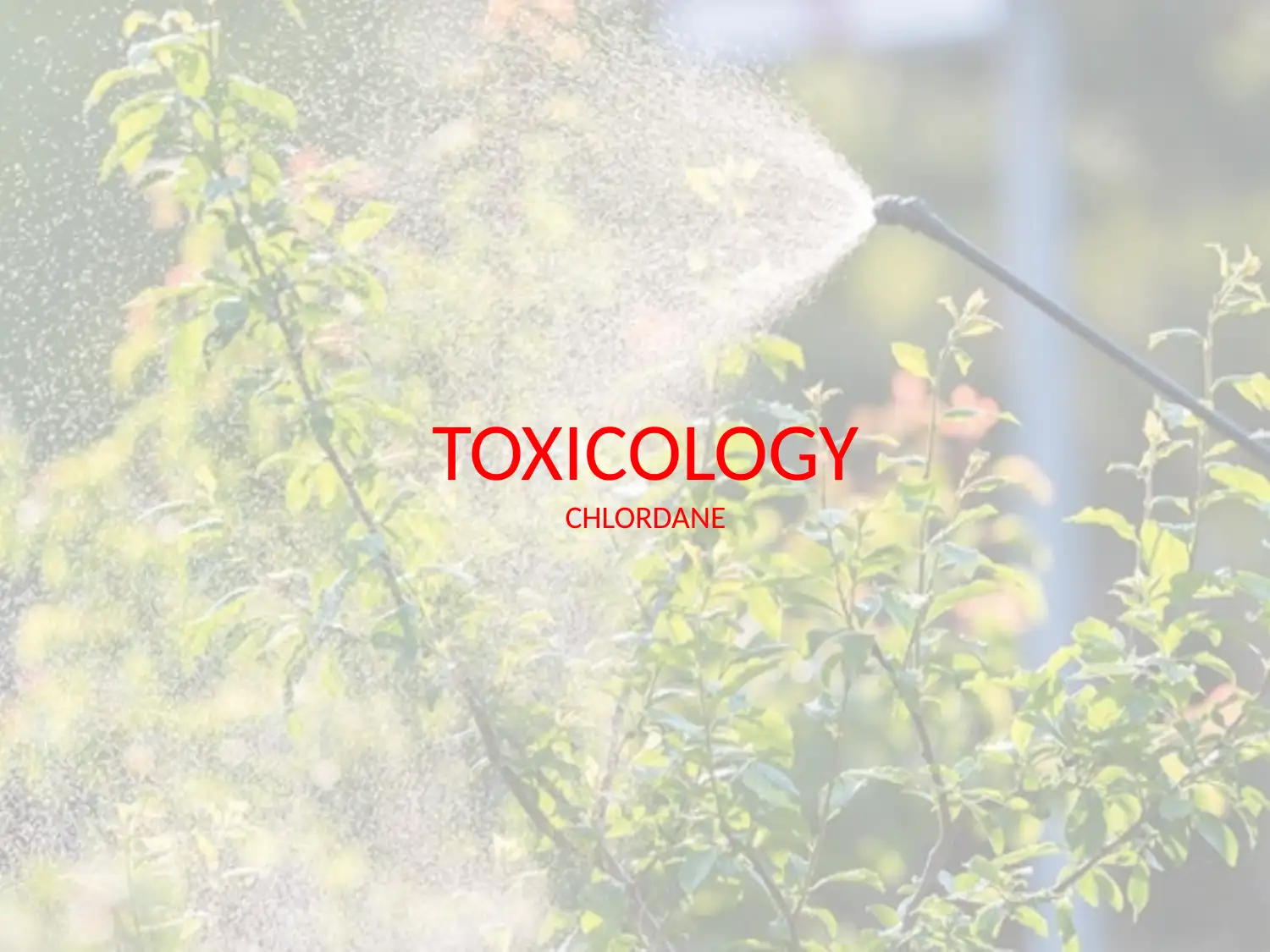
TOXICOLOGY
CHLORDANE
CHLORDANE
Secure Best Marks with AI Grader
Need help grading? Try our AI Grader for instant feedback on your assignments.
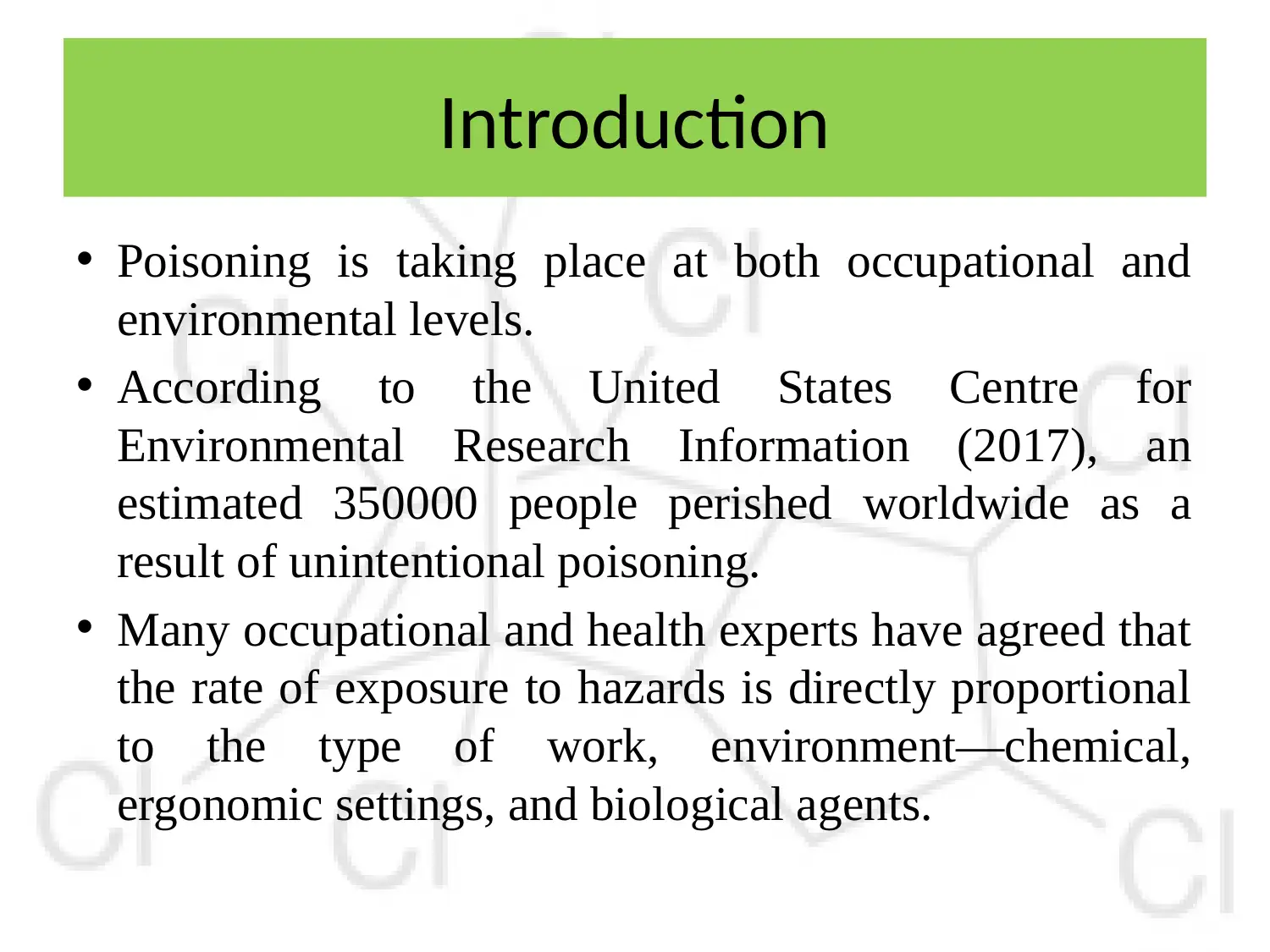
Introduction
• Poisoning is taking place at both occupational and
environmental levels.
• According to the United States Centre for
Environmental Research Information (2017), an
estimated 350000 people perished worldwide as a
result of unintentional poisoning.
• Many occupational and health experts have agreed that
the rate of exposure to hazards is directly proportional
to the type of work, environment—chemical,
ergonomic settings, and biological agents.
• Poisoning is taking place at both occupational and
environmental levels.
• According to the United States Centre for
Environmental Research Information (2017), an
estimated 350000 people perished worldwide as a
result of unintentional poisoning.
• Many occupational and health experts have agreed that
the rate of exposure to hazards is directly proportional
to the type of work, environment—chemical,
ergonomic settings, and biological agents.
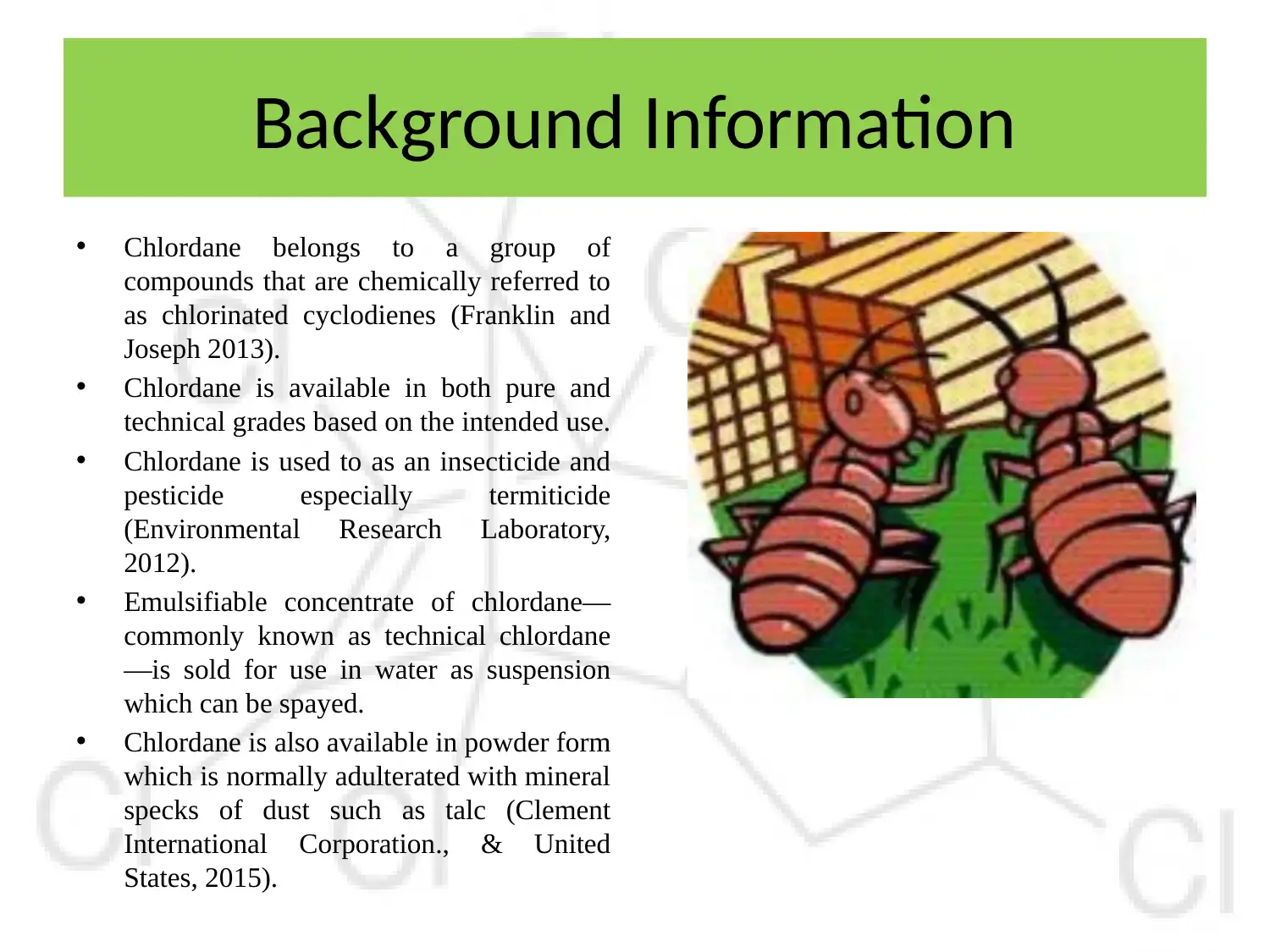
Background Information
• Chlordane belongs to a group of
compounds that are chemically referred to
as chlorinated cyclodienes (Franklin and
Joseph 2013).
• Chlordane is available in both pure and
technical grades based on the intended use.
• Chlordane is used to as an insecticide and
pesticide especially termiticide
(Environmental Research Laboratory,
2012).
• Emulsifiable concentrate of chlordane—
commonly known as technical chlordane
—is sold for use in water as suspension
which can be spayed.
• Chlordane is also available in powder form
which is normally adulterated with mineral
specks of dust such as talc (Clement
International Corporation., & United
States, 2015).
• Chlordane belongs to a group of
compounds that are chemically referred to
as chlorinated cyclodienes (Franklin and
Joseph 2013).
• Chlordane is available in both pure and
technical grades based on the intended use.
• Chlordane is used to as an insecticide and
pesticide especially termiticide
(Environmental Research Laboratory,
2012).
• Emulsifiable concentrate of chlordane—
commonly known as technical chlordane
—is sold for use in water as suspension
which can be spayed.
• Chlordane is also available in powder form
which is normally adulterated with mineral
specks of dust such as talc (Clement
International Corporation., & United
States, 2015).
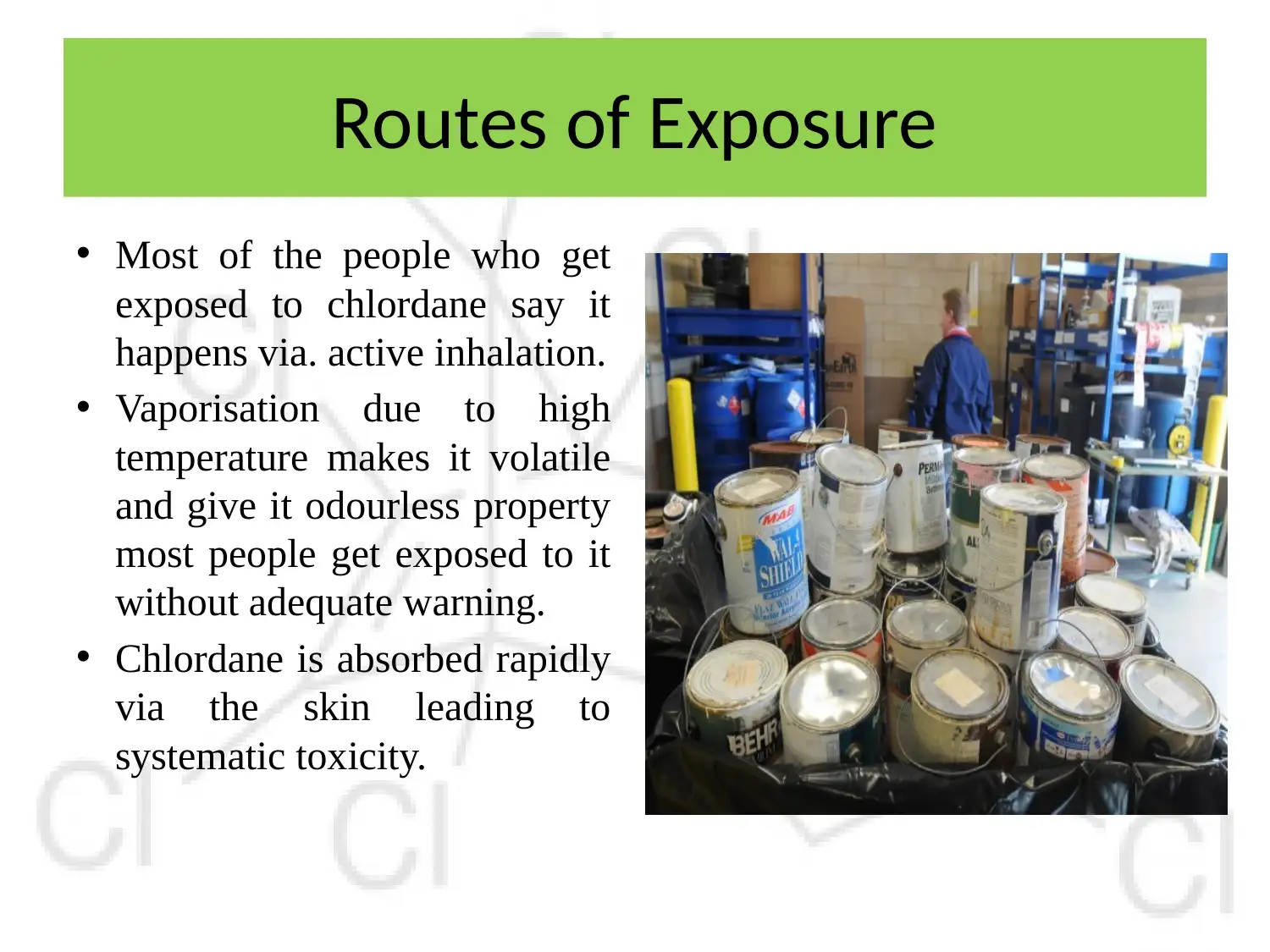
Routes of Exposure
• Most of the people who get
exposed to chlordane say it
happens via. active inhalation.
• Vaporisation due to high
temperature makes it volatile
and give it odourless property
most people get exposed to it
without adequate warning.
• Chlordane is absorbed rapidly
via the skin leading to
systematic toxicity.
• Most of the people who get
exposed to chlordane say it
happens via. active inhalation.
• Vaporisation due to high
temperature makes it volatile
and give it odourless property
most people get exposed to it
without adequate warning.
• Chlordane is absorbed rapidly
via the skin leading to
systematic toxicity.
Secure Best Marks with AI Grader
Need help grading? Try our AI Grader for instant feedback on your assignments.
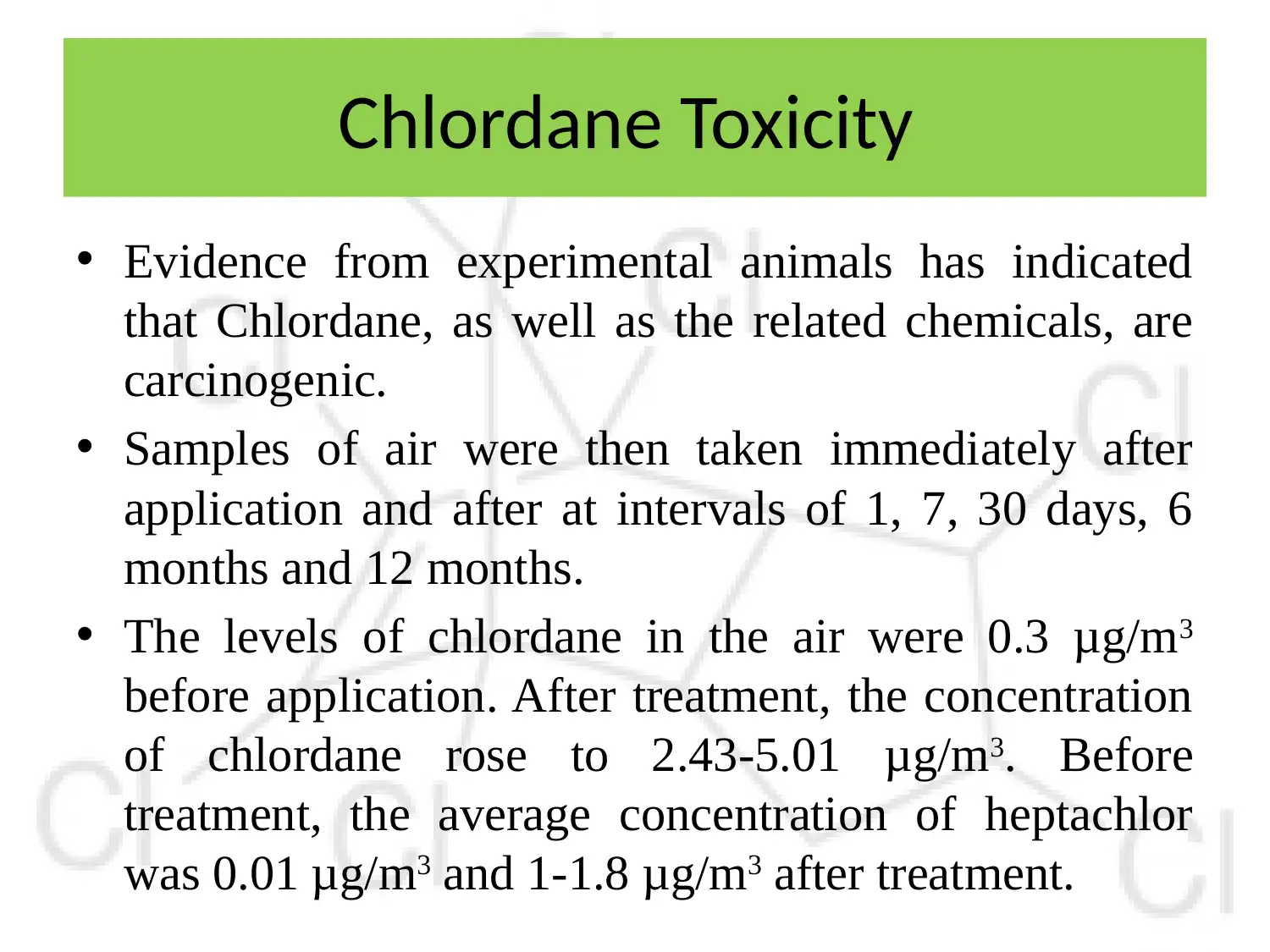
Chlordane Toxicity
• Evidence from experimental animals has indicated
that Chlordane, as well as the related chemicals, are
carcinogenic.
• Samples of air were then taken immediately after
application and after at intervals of 1, 7, 30 days, 6
months and 12 months.
• The levels of chlordane in the air were 0.3 μg/m3
before application. After treatment, the concentration
of chlordane rose to 2.43-5.01 μg/m3. Before
treatment, the average concentration of heptachlor
was 0.01 μg/m3 and 1-1.8 μg/m3 after treatment.
• Evidence from experimental animals has indicated
that Chlordane, as well as the related chemicals, are
carcinogenic.
• Samples of air were then taken immediately after
application and after at intervals of 1, 7, 30 days, 6
months and 12 months.
• The levels of chlordane in the air were 0.3 μg/m3
before application. After treatment, the concentration
of chlordane rose to 2.43-5.01 μg/m3. Before
treatment, the average concentration of heptachlor
was 0.01 μg/m3 and 1-1.8 μg/m3 after treatment.
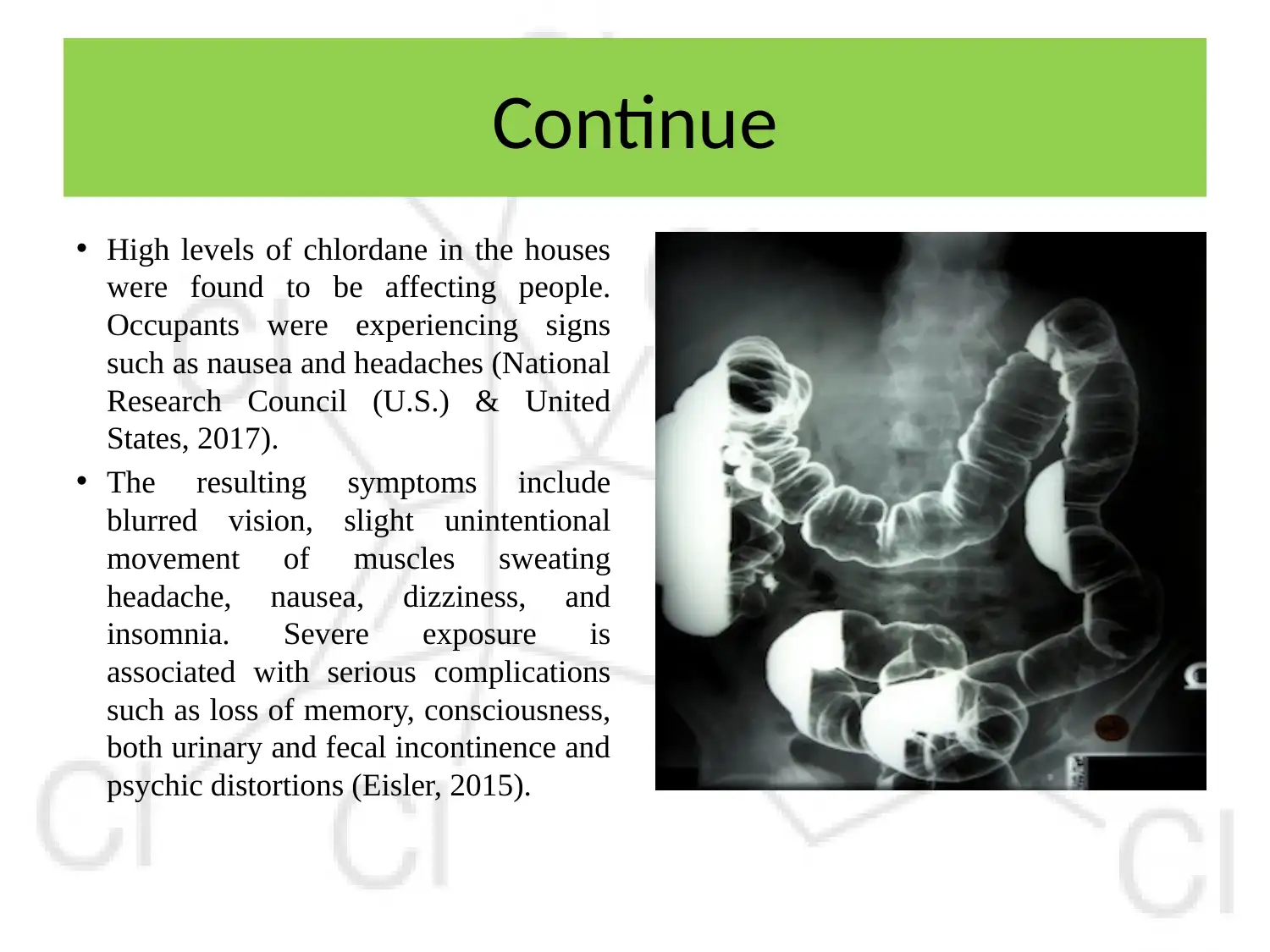
Continue
• High levels of chlordane in the houses
were found to be affecting people.
Occupants were experiencing signs
such as nausea and headaches (National
Research Council (U.S.) & United
States, 2017).
• The resulting symptoms include
blurred vision, slight unintentional
movement of muscles sweating
headache, nausea, dizziness, and
insomnia. Severe exposure is
associated with serious complications
such as loss of memory, consciousness,
both urinary and fecal incontinence and
psychic distortions (Eisler, 2015).
• High levels of chlordane in the houses
were found to be affecting people.
Occupants were experiencing signs
such as nausea and headaches (National
Research Council (U.S.) & United
States, 2017).
• The resulting symptoms include
blurred vision, slight unintentional
movement of muscles sweating
headache, nausea, dizziness, and
insomnia. Severe exposure is
associated with serious complications
such as loss of memory, consciousness,
both urinary and fecal incontinence and
psychic distortions (Eisler, 2015).
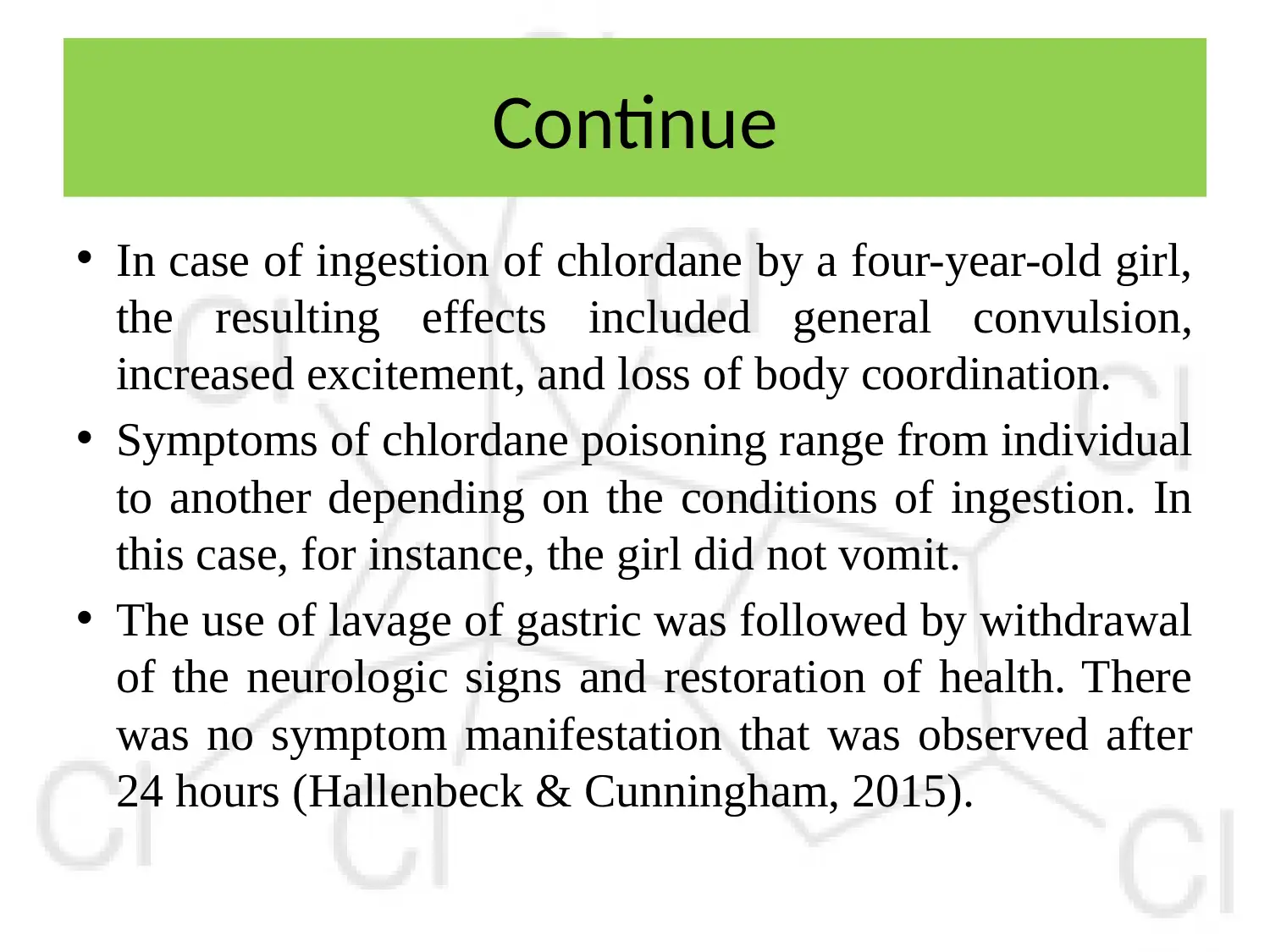
Continue
• In case of ingestion of chlordane by a four-year-old girl,
the resulting effects included general convulsion,
increased excitement, and loss of body coordination.
• Symptoms of chlordane poisoning range from individual
to another depending on the conditions of ingestion. In
this case, for instance, the girl did not vomit.
• The use of lavage of gastric was followed by withdrawal
of the neurologic signs and restoration of health. There
was no symptom manifestation that was observed after
24 hours (Hallenbeck & Cunningham, 2015).
• In case of ingestion of chlordane by a four-year-old girl,
the resulting effects included general convulsion,
increased excitement, and loss of body coordination.
• Symptoms of chlordane poisoning range from individual
to another depending on the conditions of ingestion. In
this case, for instance, the girl did not vomit.
• The use of lavage of gastric was followed by withdrawal
of the neurologic signs and restoration of health. There
was no symptom manifestation that was observed after
24 hours (Hallenbeck & Cunningham, 2015).
Paraphrase This Document
Need a fresh take? Get an instant paraphrase of this document with our AI Paraphraser

Continue
• In a case reported by Yassi (2011), a 65-year-old man was
admitted to hospital on in 2003 because of increased signs of
weakness, dyspnea, urinary, and fecal incontinence and
psychic distortions.
• Analysis of the blood samples from the man showed reduced
levels of haemoglobin in the blood.
• A born marrow examination showed aplasia for almost all the
cell elements.
• Hematologic examination proved consisted of the aplastic
anemia (Bonita, Beaglehole, Kjellström & World Health
Organization, 2016).
• Though the patient was discharged in stable health conditions,
he developed heart disorders.
• In a case reported by Yassi (2011), a 65-year-old man was
admitted to hospital on in 2003 because of increased signs of
weakness, dyspnea, urinary, and fecal incontinence and
psychic distortions.
• Analysis of the blood samples from the man showed reduced
levels of haemoglobin in the blood.
• A born marrow examination showed aplasia for almost all the
cell elements.
• Hematologic examination proved consisted of the aplastic
anemia (Bonita, Beaglehole, Kjellström & World Health
Organization, 2016).
• Though the patient was discharged in stable health conditions,
he developed heart disorders.

Occupational Exposures
An experiment comprising of
34 people involved in the
production of insecticides
containing chlordane, and had
contact through skin and
inhalation for a period of
between 11 to 36 months by
Carlson-Finnerty (2016) in
Velsicol Chemical Corporation
between 2009-2014, revealed
that there is a direct
relationship between the
symptoms shown and
chlordane poisoning.
An experiment comprising of
34 people involved in the
production of insecticides
containing chlordane, and had
contact through skin and
inhalation for a period of
between 11 to 36 months by
Carlson-Finnerty (2016) in
Velsicol Chemical Corporation
between 2009-2014, revealed
that there is a direct
relationship between the
symptoms shown and
chlordane poisoning.

Continue
• Physical examinations, blood, kidney, and born marrow
examinations suggested abnormalities in the workers
(Carlson-Finnerty, 2016).
• Analysis of the blood samples from the worker showed
reduced levels of hemoglobin in the blood.
• A born marrow examination showed aplasia for almost all the
cell elements.
• Hematologic examination proved there was aplastic aneamia.
• In the same organization, the employee mortality rate was
also unusually high with most of the deaths happening as a
result of organ failure.
• Physical examinations, blood, kidney, and born marrow
examinations suggested abnormalities in the workers
(Carlson-Finnerty, 2016).
• Analysis of the blood samples from the worker showed
reduced levels of hemoglobin in the blood.
• A born marrow examination showed aplasia for almost all the
cell elements.
• Hematologic examination proved there was aplastic aneamia.
• In the same organization, the employee mortality rate was
also unusually high with most of the deaths happening as a
result of organ failure.
Secure Best Marks with AI Grader
Need help grading? Try our AI Grader for instant feedback on your assignments.
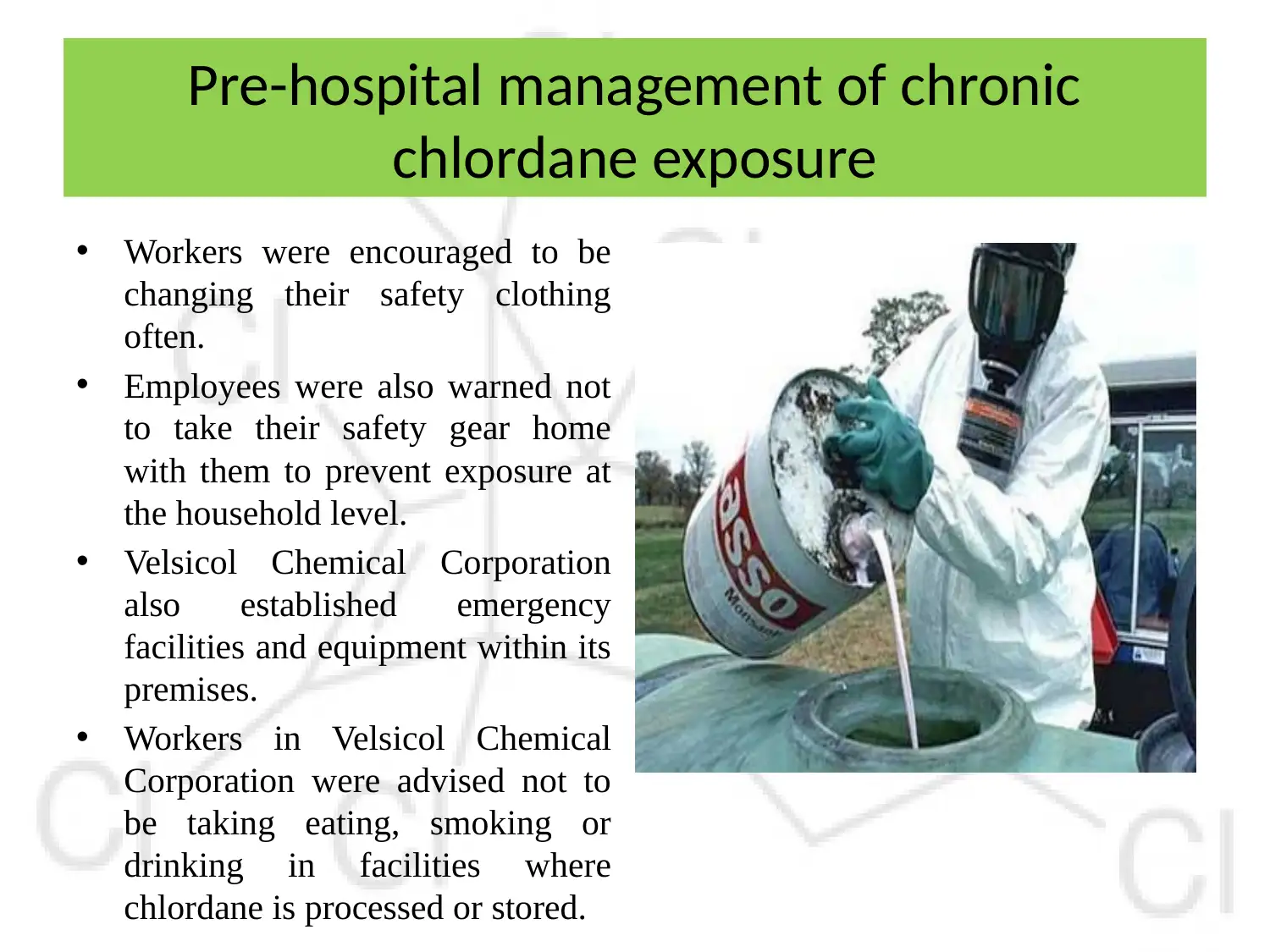
Pre-hospital management of chronic
chlordane exposure
• Workers were encouraged to be
changing their safety clothing
often.
• Employees were also warned not
to take their safety gear home
with them to prevent exposure at
the household level.
• Velsicol Chemical Corporation
also established emergency
facilities and equipment within its
premises.
• Workers in Velsicol Chemical
Corporation were advised not to
be taking eating, smoking or
drinking in facilities where
chlordane is processed or stored.
chlordane exposure
• Workers were encouraged to be
changing their safety clothing
often.
• Employees were also warned not
to take their safety gear home
with them to prevent exposure at
the household level.
• Velsicol Chemical Corporation
also established emergency
facilities and equipment within its
premises.
• Workers in Velsicol Chemical
Corporation were advised not to
be taking eating, smoking or
drinking in facilities where
chlordane is processed or stored.
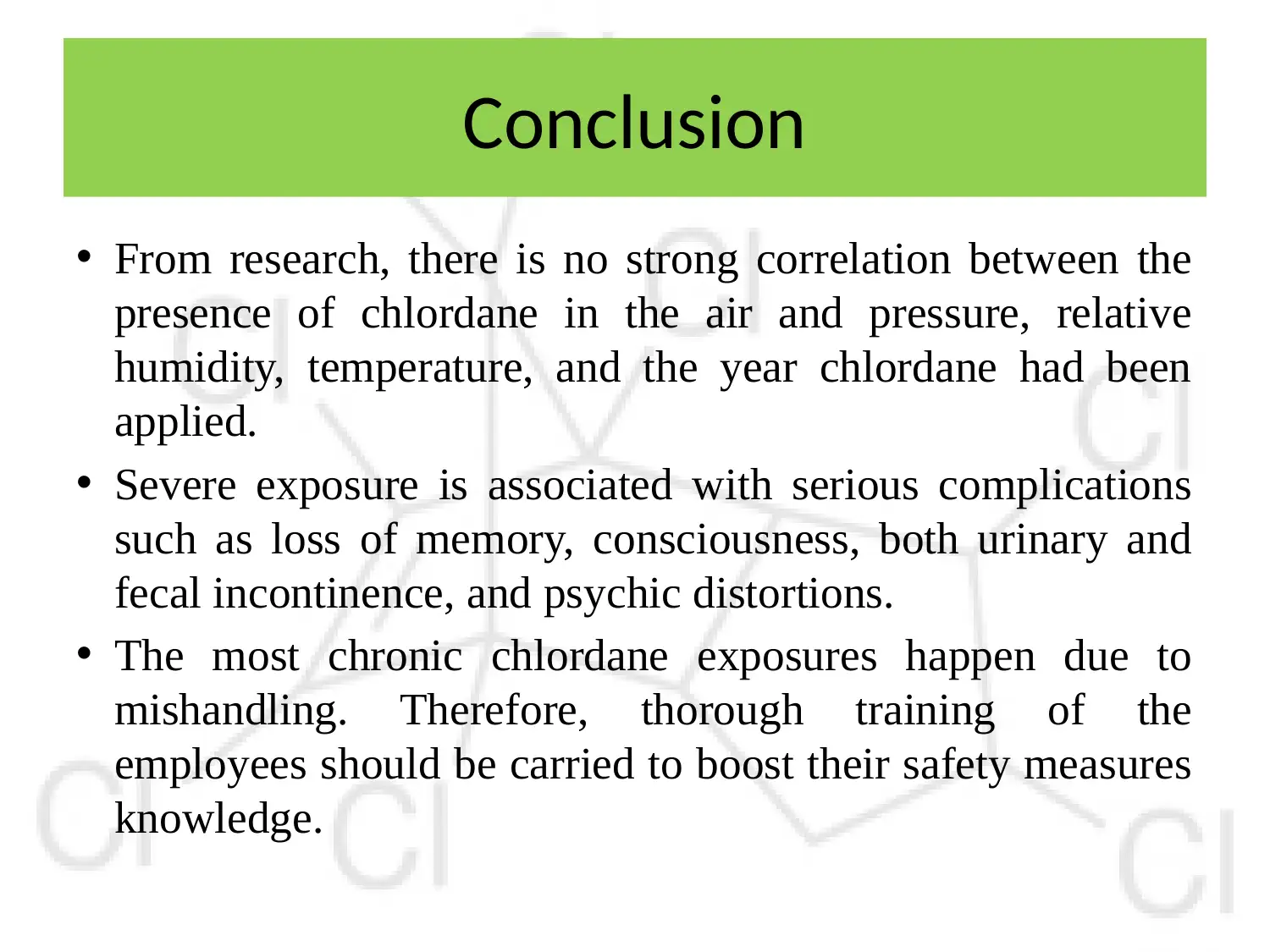
Conclusion
• From research, there is no strong correlation between the
presence of chlordane in the air and pressure, relative
humidity, temperature, and the year chlordane had been
applied.
• Severe exposure is associated with serious complications
such as loss of memory, consciousness, both urinary and
fecal incontinence, and psychic distortions.
• The most chronic chlordane exposures happen due to
mishandling. Therefore, thorough training of the
employees should be carried to boost their safety measures
knowledge.
• From research, there is no strong correlation between the
presence of chlordane in the air and pressure, relative
humidity, temperature, and the year chlordane had been
applied.
• Severe exposure is associated with serious complications
such as loss of memory, consciousness, both urinary and
fecal incontinence, and psychic distortions.
• The most chronic chlordane exposures happen due to
mishandling. Therefore, thorough training of the
employees should be carried to boost their safety measures
knowledge.
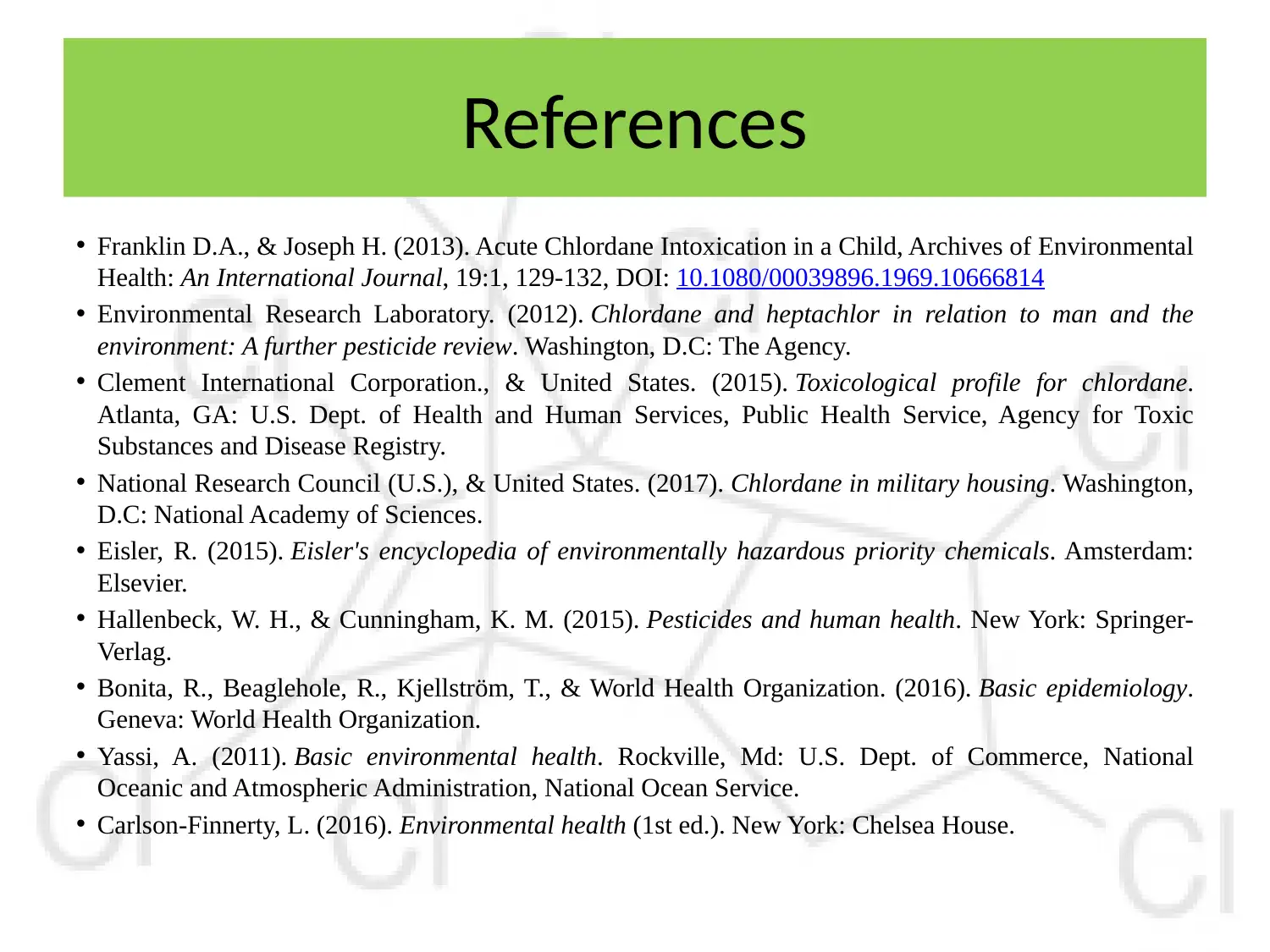
References
• Franklin D.A., & Joseph H. (2013). Acute Chlordane Intoxication in a Child, Archives of Environmental
Health: An International Journal, 19:1, 129-132, DOI: 10.1080/00039896.1969.10666814
• Environmental Research Laboratory. (2012). Chlordane and heptachlor in relation to man and the
environment: A further pesticide review. Washington, D.C: The Agency.
• Clement International Corporation., & United States. (2015). Toxicological profile for chlordane.
Atlanta, GA: U.S. Dept. of Health and Human Services, Public Health Service, Agency for Toxic
Substances and Disease Registry.
• National Research Council (U.S.), & United States. (2017). Chlordane in military housing. Washington,
D.C: National Academy of Sciences.
• Eisler, R. (2015). Eisler's encyclopedia of environmentally hazardous priority chemicals. Amsterdam:
Elsevier.
• Hallenbeck, W. H., & Cunningham, K. M. (2015). Pesticides and human health. New York: Springer-
Verlag.
• Bonita, R., Beaglehole, R., Kjellström, T., & World Health Organization. (2016). Basic epidemiology.
Geneva: World Health Organization.
• Yassi, A. (2011). Basic environmental health. Rockville, Md: U.S. Dept. of Commerce, National
Oceanic and Atmospheric Administration, National Ocean Service.
• Carlson-Finnerty, L. (2016). Environmental health (1st ed.). New York: Chelsea House.
• Franklin D.A., & Joseph H. (2013). Acute Chlordane Intoxication in a Child, Archives of Environmental
Health: An International Journal, 19:1, 129-132, DOI: 10.1080/00039896.1969.10666814
• Environmental Research Laboratory. (2012). Chlordane and heptachlor in relation to man and the
environment: A further pesticide review. Washington, D.C: The Agency.
• Clement International Corporation., & United States. (2015). Toxicological profile for chlordane.
Atlanta, GA: U.S. Dept. of Health and Human Services, Public Health Service, Agency for Toxic
Substances and Disease Registry.
• National Research Council (U.S.), & United States. (2017). Chlordane in military housing. Washington,
D.C: National Academy of Sciences.
• Eisler, R. (2015). Eisler's encyclopedia of environmentally hazardous priority chemicals. Amsterdam:
Elsevier.
• Hallenbeck, W. H., & Cunningham, K. M. (2015). Pesticides and human health. New York: Springer-
Verlag.
• Bonita, R., Beaglehole, R., Kjellström, T., & World Health Organization. (2016). Basic epidemiology.
Geneva: World Health Organization.
• Yassi, A. (2011). Basic environmental health. Rockville, Md: U.S. Dept. of Commerce, National
Oceanic and Atmospheric Administration, National Ocean Service.
• Carlson-Finnerty, L. (2016). Environmental health (1st ed.). New York: Chelsea House.
1 out of 13
Your All-in-One AI-Powered Toolkit for Academic Success.
+13062052269
info@desklib.com
Available 24*7 on WhatsApp / Email
![[object Object]](/_next/static/media/star-bottom.7253800d.svg)
Unlock your academic potential
© 2024 | Zucol Services PVT LTD | All rights reserved.